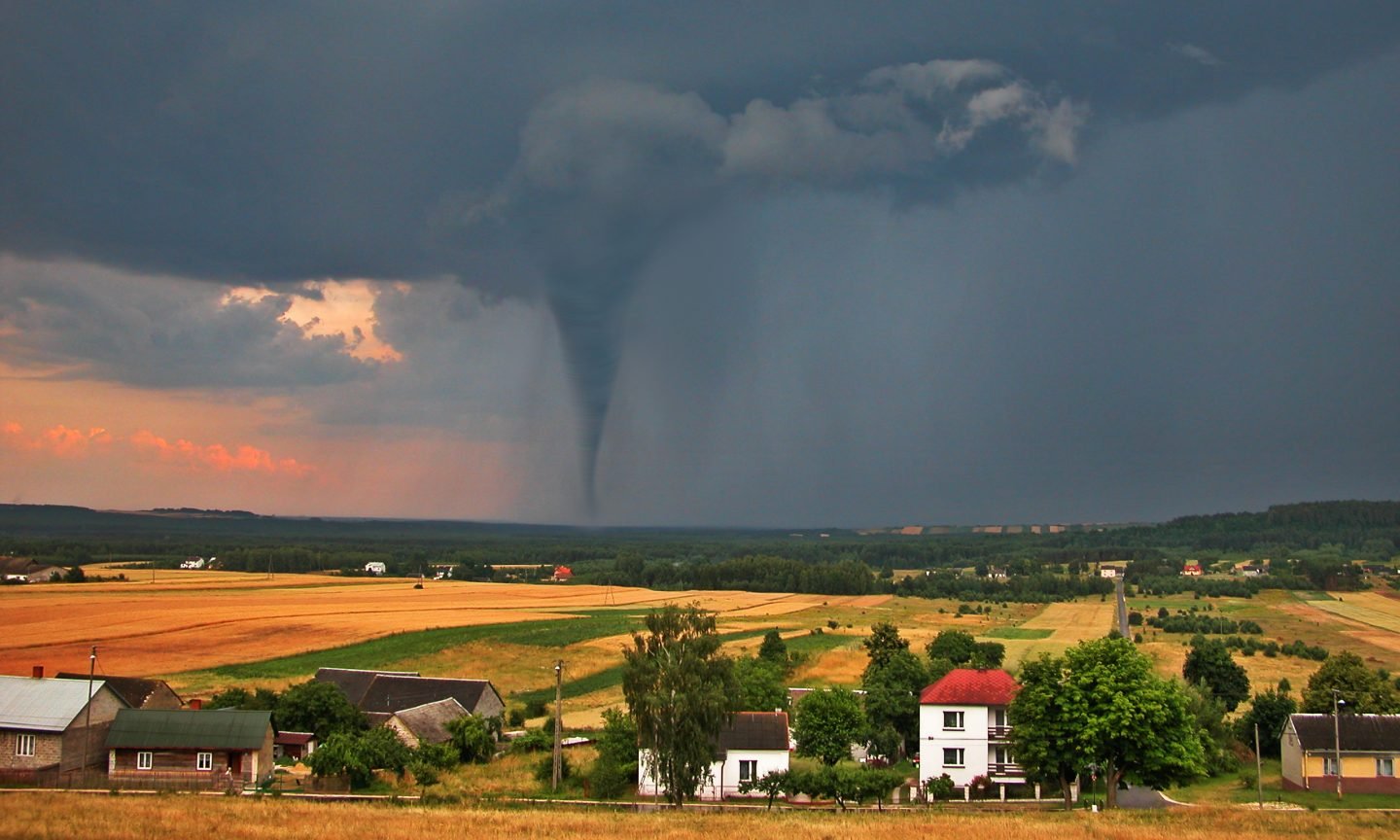[ad_1]
If your home is damaged or destroyed by a tornado, your homeowners insurance will likely help cover the costs to rebuild. Figuring out what damage your home insurance covers isn’t always straightforward, though.
About 1,200 tornadoes touch down in the United States during a typical year, according to NOAA’s National Severe Storms Laboratory. Given that tornadoes often strike with little warning, it’s important to understand what damage your home insurance policy covers before a storm hits.

Get home insurance quotes in minutes
Answer a few questions to see custom quotes and find the right policy for you.
Does homeowners insurance cover tornado damage?
Violent winds are responsible for most destruction during a tornado. Hail can also form during these storms. Standard home insurance policies typically cover damage from windstorms and hail.
The most common type of home insurance is called an HO-3 policy. With these policies, dwelling coverage is offered on an “open perils” basis. (A peril is an event that could result in property damage.) That means your home insurance will generally cover damage to your home’s structure, as long as it wasn’t caused by a peril that was specifically excluded by the policy. Windstorm and hail damage are generally not among those exclusions.
Your belongings are typically covered on a “named peril” basis, which means that the cost to replace or repair your stuff will be covered as long as the cause of the damage was specifically mentioned in your policy. For most standard home insurance policies, this includes damage caused by windstorm and hail.
HO-1 and HO-2 insurance policies, which only cover specific perils named in the insurance contract, also typically include damage from windstorm and hail as a named peril. (These policies tend to be less common.)
🤓Nerdy Tip
If you live in an area at high risk of a tornado, windstorm and hail damage may be excluded by your policy. In that event, you’d need to buy a separate windstorm policy for financial protection against wind destruction.
But even if your home policy doesn’t exclude windstorm and hail damage (or includes it as a named peril), don’t assume all tornado damage is covered by homeowner insurance. Almost all home policies contain exclusions for things like flooding and damage attributed to poor maintenance.
So if your home floods as a result of torrential rains that accompany a tornado, your home insurance policy is unlikely to cover the damage. You’d need a separate flood insurance policy to recoup your losses.
Or suppose that heavy winds cause a tree on your property to fall on your home. If the insurer finds the tree was rotting and should have been removed prior to the storm, it could determine the damage was due to lack of maintenance and refuse to pay for repairs.
What types of homeowner insurance applies to tornado damage?
When it comes to tornado damage, a few different types of homeowners insurance coverage may come into play.
Be aware that you’ll need to pay your home insurance deductible before insurance kicks in. For example, if you have a $1,000 deductible and $10,000 worth of damage, your insurer would pay the remaining $9,000.
A deductible applies to your dwelling coverage, personal property coverage and other structures coverage. However, you don’t typically owe a deductible for additional living expenses coverage.
Dwelling coverage (Coverage A)
All home and condo policies include dwelling coverage. This insurance pays to repair or rebuild your home and attached structures, like a garage or deck, after a tornado or another disaster.
Personal property coverage (Coverage C)
Homeowner, condo and renters insurance policies usually include personal property coverage, which reimburses you if your personal belongings — like furniture, electronics, clothing and jewelry — are destroyed. For example, if tornado winds sent debris crashing through your window, your dwelling coverage would typically pay to repair the window. But if that debris also shattered your TV, your personal property coverage would pay for the cost.
Additional living expenses insurance (Coverage D)
Additional living expenses insurance (sometimes called loss of use coverage) reimburses you for costs you incur if your residence becomes uninhabitable as the result of a covered peril. If you’re forced to relocate to a hotel due to tornado damages, this insurance may cover the cost of your stay plus any additional costs like restaurant meals or boarding your pet.
Other structures (Coverage B)
Other structures insurance covers the cost of repairing or replacing fixtures that aren’t attached to the main home. For example, if tornado winds damage your fence or detached garage, other structures insurance pays to fix the damage.
Replacement cost vs. actual cash value
It’s essential to know whether your home insurance covers you for the replacement cost vs. actual cash value cost of your property. Replacement costs cover the amount needed to rebuild or replace a damaged property, whereas coverage for actual cash value applies depreciation and pays according to its market value.
Usually, dwelling insurance provides coverage for replacement costs unless you own an older home. Personal property is often only insured at actual cash value, though, which can result in large out-of-pocket expenses. Suppose a tornado destroyed a couch you bought several years ago for $1,000. Due to depreciation, your insurer may say its cash value is only $400, even though you may need $1,000 or more to buy a similar couch.
🤓Nerdy Tip
You may be able to upgrade your policy to replacement cost coverage for personal property for an additional cost.
How do wind and hail deductibles work?
Separate wind and hail deductibles often apply to policies that insure areas at high risk of severe windstorms, like the Great Plains region known as Tornado Alley. Wind and hail deductibles are similar to the deductibles on hurricane insurance in that they’re often applied separately from standard policy deductibles. Usually, these are charged as a fixed percentage of the home’s insured value ranging from 1% to 5%.
How to prepare for a tornado
Tornadoes can strike with little warning, but taking these steps ahead of time can help protect you, your loved ones, and your home and property, according to the Centers for Disease Control and Prevention.
-
Create a safety plan and practice it. Find a safe place in your home, and hold a safety drill to make sure it’s accessible to all people and pets in the household.
-
Make a disaster kit. Your disaster kit should include at least three days’ worth of nonperishable food and water, batteries, flashlights, medications, first aid supplies and cash.
-
Read over your insurance policies. Look over your insurance documents, including your homeowner and auto insurance, so that you understand your coverage.
-
Store important documents. Put important documents like birth certificates, passports, insurance policies and leases in a safe, safety deposit box or fire box.
-
Take a home inventory. Take pictures of each room in your home and compile a list of all valuables (including serial numbers, if applicable). Thorough documentation will be helpful if you need to file an insurance claim.
What to do after a tornado
The most important thing to do after a tornado is ensure all the people and animals in your home are safe. Seek medical treatments for any injuries as soon as possible. Don’t enter damaged structures if you’re not sure they’re safe. Once you’re confident you and your loved ones are safe, follow these steps to mitigate the financial damage.
-
Contact your insurance company. Find out what your policy covers and how to file a storm damage claim. Ask about any deadlines, as well as how their claims process works.
-
Document all damage. Take photos and make a list of all damage to support your insurance claim.
-
Go ahead with smaller repairs, but save receipts. Make any repairs necessary to avoid additional damage. If you do make repairs, hang on to the receipts for insurance reimbursement.
-
Get approval from your adjuster before making major repairs. If your home has suffered substantial damage, get your adjuster to sign off before you begin major repairs.
[ad_2]
Source link

